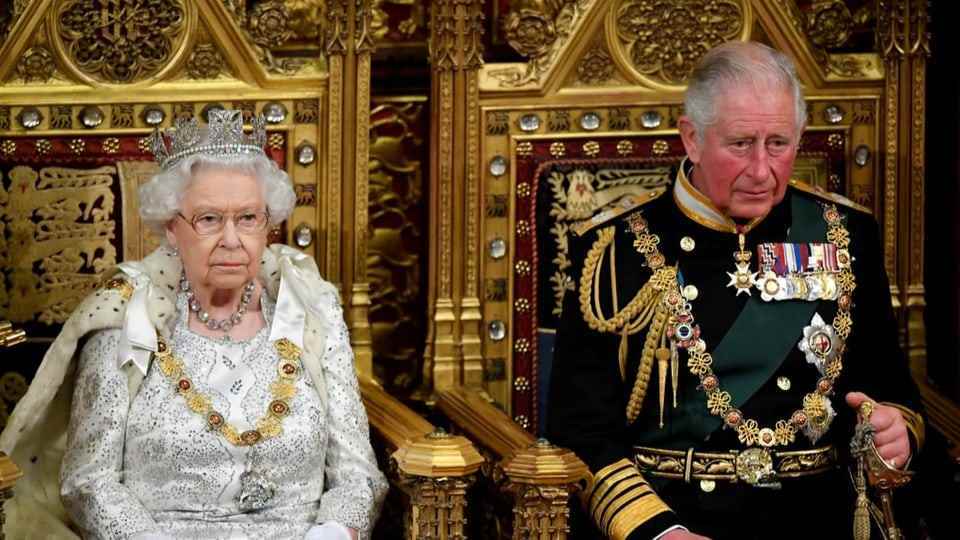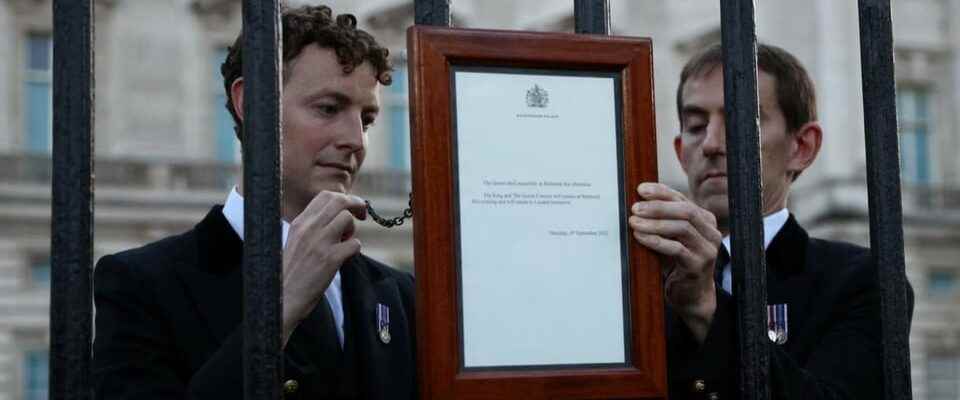“London Bridge is down.” With this sentence – in German something like “London Bridge has collapsed” – the Queen’s private secretary informed the British Prime Minister that Queen Elizabeth II is dead. The day the Queen dies is called D-Day. Each subsequent day up to the day of the burial is referred to as D-Day+1, D-Day+2 and so on. Since the death was only announced on Thursday evening, Friday is considered D-Day, according to the British news agency PA and the broadcaster BBC, in order to facilitate the complex planning. These are the expected next steps according to the Association of Foreign Press in Great Britain:
Legend:
Staff put up a sign on a fence outside Buckingham Palace announcing the death of Queen Elizabeth.
REUTERS/Henry Nicholls
D-Day+0, Friday
- The new King Charles III. and his wife Camilla return to London from the Scottish country estate of Balmoral.
- First meeting of the King with the new Prime Minister Liz Truss. All parliamentary work is suspended for ten days.
- The king is expected to make a televised address to the nation.
- Possibly a service in St. Paul’s Cathedral in London, which the Prime Minister is also supposed to attend.

Legend:
Charles, the Queen’s eldest son, will now become the monarch of the United Kingdom. (Recording from October 2019)
REUTERS/Toby Melville
D-Day+1, Saturday
- A council occurs by 10 o’clock together to proclaim the king as the new monarch. The proclamation is read at St James’s Palace and at the Royal Exchange, site of London’s first stock exchange, confirming Charles as king.
- The Prime Minister and Cabinet will meet King Charles III. meet.
D-Day+2, Sunday
- The Queen’s body is first transferred from Balmoral to Holyrood Palace in Edinburgh, the Queen’s residence in Scotland. He is also to be laid out in Edinburgh.
D-Day+3, Monday
- The new king will receive the condolences at Westminster Hall.
- He then embarks on a mourning journey across the UK: first to Scotland, then to Northern Ireland and then Wales in the days that follow.
D-Day+4, Tuesday
- The Queen’s coffin is being transported to London and will initially remain in Buckingham Palace.
- There is a rehearsal for the procession carrying the coffin from Buckingham Palace to the Houses of Parliament Palace of Westminster.
D-Day+5, Wednesday
- The Queen’s coffin is transferred from Buckingham Palace to the Houses of Parliament Palace of Westminster on a route through London. Hundreds of thousands of people are expected in London from now on. A memorial service will be held in Westminster Hall.
D-Day+6, Thursday
- The Queen is laid out in the Palace of Westminster for three days. The coffin will be open to the public 23 hours a day.
- Rehearsal for the state funeral procession.
D-Day+7, Friday
- The first guests from the Commonwealth countries are expected for the state funeral.
D-Day+8 and 9, Saturday and Sunday
- The body will continue to be laid out in the coffin. Crowds are expected in London to pay their last respects to the Queen. Condolence books will be opened online.
D-Day+10, Monday
- The day of mourning shall be a national holiday.
- The state funeral takes place in Westminster Abbey. In addition to the royal family, numerous heads of state and government as well as members of European royal houses are expected.
- There will be two minutes of silence at noon across the country.
- The Queen is born at Windsor Castle in the King George VI. Memorial Chapel buried next to her father. The coffin of her husband Prince Philip, who died last April, is moved to his wife’s side.
